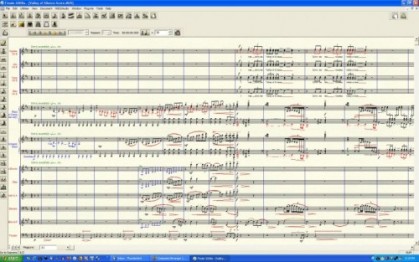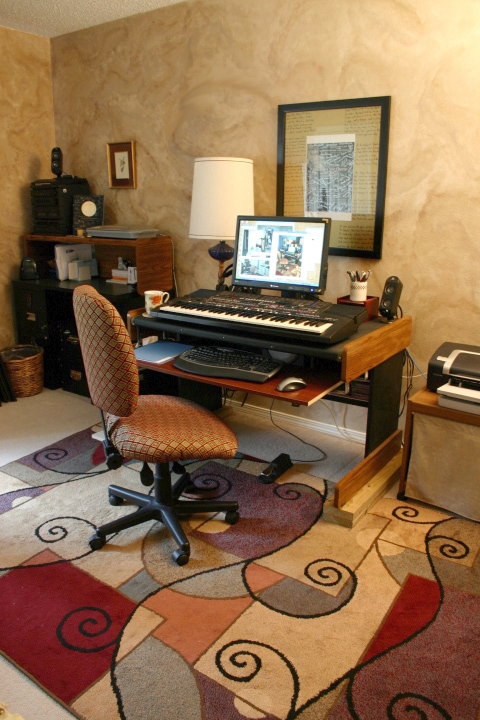
Finale Work
In the late 80s, when I bought my first Macintosh computer to write music, it was so exciting. The first music writing software I tried was the Deluxe Music Construction Set. It wasn't fancy but it was all I could afford at the time ($100).
I later upgraded to Finale and I must admit that I wasn't much of a computer person at the time. It was around this time I met my husband, David. He was working in the Mac Lab at WT helping other students learn Finale so he really got me off to a good start writing music on the computer.
Many Finale versions later and many computers later, I'm still writing using Finale software in my studio (pictured right). This was the original computer desk I bought back in the 80s when I bought my first Macintosh. That Macintosh was later given to a friend and now I think it's an aquarium!! I still use the same desk but made some modifications on it. I installed a pullout shelf below the table top for the piano keyboard. I like having the piano in front of me while playing through the music. A couple of years ago I switched to a PC but I still have my G4 Mac and use it. The Gateway monitor is great for writing orchestral scores. When rotated from a landscape to a portrait position, I can see an entire page of an orchestral score without scrolling around which is great when editting or filling in parts. The landscape position is great for viewing large sections of music. I can clearly see about 12-16 bars of music at a time.
Writing music on the computer took a little time to transition from the days of writing by hand. It was difficult at first to compose with the right brain while remembering commands with the left. I would pencil out my composing ideas on paper and then put them in on the computer which was defeating the purpose somewhat. Over time, I eventually got very comfortable with using the computer and now I can compose directly to the computer.
I can't imagine trying to compose some of the pieces I've done without the use of a computer. I'm definitely not a Mozart or Beethoven type who can write whatever I hear in my head. I'm very fortunate to live in an age where I can use a computer to try out all the ideas I have. That "undo key" and copy and paste features are the greatest inventions, not to mention the transposition menus. After all the years that I was hand writing music with ink and vellum, you can imagine the joy I get from printing out my own music that looks like it came from a publisher.
The computer has also been helpful in my composing life when it comes to communication. A composer can easily collaborate via email with those who have commissioned them. When writing the commissioned work "Valley of Silence", I would often email Steve Weber at Amarillo College with ideas to discuss as I went through the process of writing. It began with emailing text ideas for lyrics and continued with sections of music. Eventually I would email a PDF of the music to Steve, who then would print it out and distribute it to the chorus for rehearsal. As we made revisions, I would email the modified pages to him. It was a time saving process that worked so well, I continued using it for the commission with Amarillo High's Bel Canto Men. Susan Hinrichs, Director of Bel Canto and I would exchange dozens of poems to consider for the new work. Once we settled on "Do Not Stand at My Grave and Weep" by Mary Frye for our text, I began the composing process. When a section was shaping up, I would email Susan PDFs and MP3s samples made from Finale for her to review. We both enjoyed this time saving process and I will probably continue it with future commissions. I often think about what Mozart or Beethoven would have done if they had a computer in their time.

